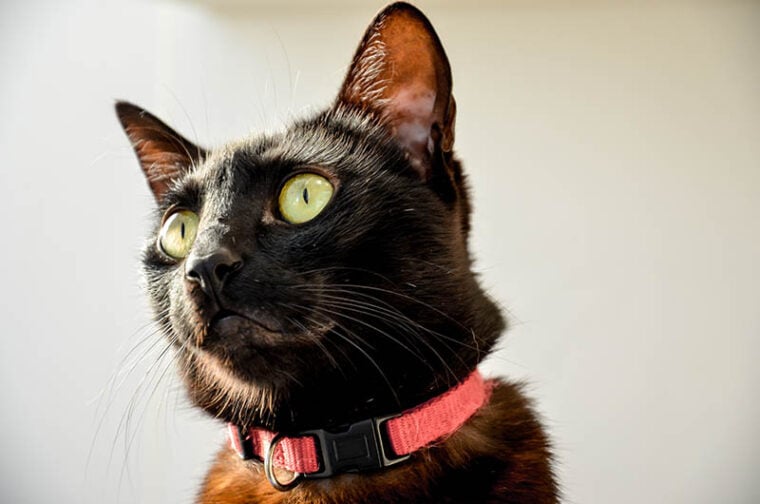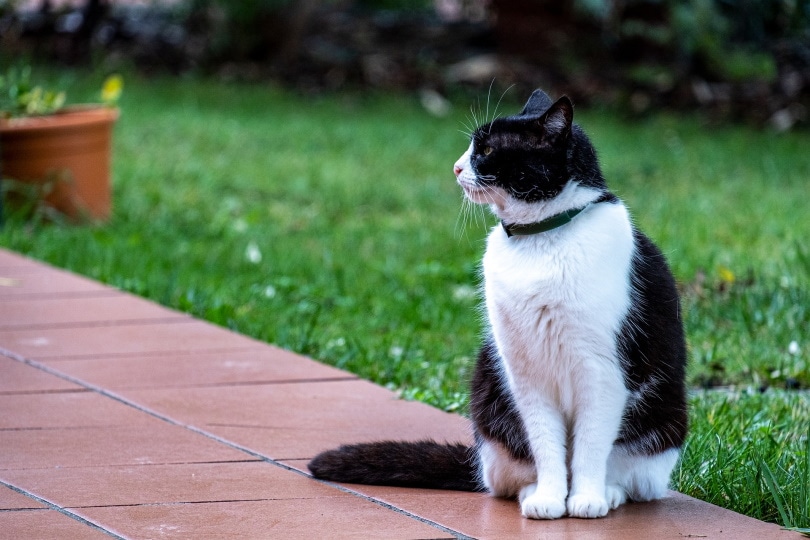
Click to Skip Ahead
Although you will probably never take your cat for a walk on a leash, a collar is still essential. A collar holds your cat’s ID tag so your neighbor can return them to you should they ever wander off. Even if yours is strictly an indoor cat, most veterinarians recommend giving them a collar in case they accidentally get out.
If you decide to give your cat a collar, one consideration is whether to purchase a traditional or a breakaway collar. A breakaway (aka quick release) collar is a collar with a special clasp that, as the name suggests, breaks away if your cat pulls on it hard enough. While that might sound like it defeats the purpose of having a collar, a breakaway collar can save your cat’s life. Read on to discover how breakaway collars work and why they could be a godsend if your cat’s in trouble.
How Does It Work?
Breakaway collars were designed with one thing in mind: saving your cat’s life. Cats love to squeeze into tight spaces, climb trees or high cabinets, and generally explore their surroundings. Traditional cat collars get snagged on tree branches, hooked on fences, and stuck on cabinet knobs or hooks. In some cases, a cat can get its front leg (or both legs) stuck in its collar and be unable to get free.
These situations can be deadly, causing your cat to choke, be asphyxiated, accidentally hang itself, or get mauled by a larger animal. Sadly, some cats have had their leg amputated after it was stuck in their collar for hours or days on end.
The breakaway collar prevents these damaging and deadly situations from happening. Breakaway collars have a specialized clasp that’s very similar to the clip on a backpack, except that when enough force is applied, the clasp pulls apart. On a backpack, that would be a bad thing, but if your cat is stuck or snagged on something, a clasp that can pull apart and let them loose would be a lifesaver.
A breakaway or quick-release collar comes apart thanks to the clasp’s unique design. Unlike a regular clasp, the two prongs on a breakaway clasp are designed to be weaker, and the ends are rounded instead of barbed. A small amount of force won’t pull them open, but a quick, hard tug will, releasing your cat from its collar if it’s in trouble.
Over the years, breakaway clasps on cat collars have been redesigned and improved several times. That way, if your cat is playing or squeezing through an opening with no problem, it won’t come open and come off from the slight force or pressure being applied.
One important thing to note is that a quick-release collar made for a dog is not a breakaway collar. Quick-release collars for dogs feature a clasp identical to the one you would find on the backpack we used earlier as an example. They are called “quick-release” collars because you can open them quickly by squeezing the clasp with your fingers. That’s why, even if it fits your cat, you shouldn’t give them a quick-release dog collar.
What Are the Types of Breakaway Collars?
Breakaway collars are made with various materials, including nylon, leather, cotton, and several others. You’ll find them in different sizes, too, and many breakaway cat collars are made with reflective material to keep your kitty safer at night.
The clasp on a breakaway collar is more or less the same from one manufacturer to another. Yes, they come in different shapes and colors and have other slightly different design features, but all are made to come open when a quick tugging force is applied.
One other type of collar for cats you might encounter when searching is a so-called stretch collar. Stretch collars are made with stretchy material like you would find in a bungee cord. They’re designed to stretch if they get snagged on something and, presumably, allow your cat to get free. However, like a traditional collar, a stretch collar can cause the same dangerous and deadly entanglements. Also, stretch collars are challenging to fit correctly on your cat due to their elastic nature.

Where Is It Used?
Breakaway collars are used almost exclusively for cats due to their curious nature and fondness for wandering around outdoors. Cats also are great climbers, but that innate ability can get them into trouble even in a “safe” home. The reason is that, even indoors, your cat’s collar could get stuck, hooked, or otherwise jammed on something that could hurt or even kill them if they can’t get free.
Since the advent of breakaway collars, you’ll find that most veterinarians and cat experts recommend using only this type for your cat and not using traditional collars at all. That’s because too many cats have been hurt and killed while wearing a standard collar.
If you have a cat that likes to go on walks with you, like a Bengal, you need to use a traditional collar that doesn’t break away if there’s a sudden, sharp pull. That could be very bad if you’re stopped at a busy intersection. After arriving home, however, you should remove the traditional collar and put your cat’s breakaway collar back in its place.
Advantages of Breakaway Collars
The major advantage of a breakaway collar is that if your cat gets hung up, stuck, or entangled in its collar, the clasp (buckle) will come open, releasing the collar and your cat with it. This advantage is the only one a breakaway collar provides, but it’s also the biggest. Whether indoors or outside, if your cat gets into a situation that might hurt or even kill them wearing a traditional collar, a breakaway collar could save their life.
The best cat collars are sturdy, comfortable, and safe. Our favorite is Hepper's Breakaway Collar, a well-designed collar made from 100% natural hemp webbing that softens as your cat wears it. Featuring a quick-release buckle, adjustable slip-locks, and a jingle bell, this collar is as practical as it is stylish!
- Hemp-Hemp Hooray - hemp breakaway cat collars are long-lasting and resistant to UV rays – The...
- What the neck?! - Our cat breakaway collar has adjustable sizing with metal slip-locks, and softens...
- Breakaway Safety - Cat collars breakaway to ensure that when out adventuring, the material getting...
At Pet Keen, we've admired Hepper for many years, and decided to take a controlling ownership interest so that we could benefit from the outstanding designs of this cool cat company!
Disadvantages of Breakaway Collars
There are two significant disadvantages of a breakaway collar. The first is that if your cat’s collar breaks away when you’re not around and don’t know where it happened, you will lose it and need to purchase another.
The second disadvantage is that if your cat’s breakaway collar breaks away and is lost, its ID tag will also be lost. If your cat then starts roaming around the neighborhood, the person who finds them won’t know who or how to get in touch with you. For this reason, most vets recommend having your cat’s ID chipped or their ear tattooed as a backup safety measure.
Frequently Asked Questions (FAQ)
| Q: Are all breakaway collars the same? |
| A: Like any product, some breakaway collars are of higher quality than others. Be sure to do your due diligence, read reviews, and check to ensure the breakaway collar you purchase is made with quality materials. |
| Q: Should all cats wear breakaway collars? |
| A: While most vets recommend breakaway collars above traditional collars, in some cases, a conventional collar will be OK. For example, an older cat that’s not as mobile would probably be fine with a traditional collar. |
| Q: Are quick-release colors and breakaway collars the same? |
| A: Yes and no. Some manufacturers refer to their breakaway collars as quick-release collars. However, a traditional cat collar can also be referred to as a quick-release because, with two fingers, you can release it quickly. The type of clasp this collar uses will not break away when force is applied. In short, be sure to check that the clasp is a breakaway and not a traditional quick-release clasp. |
| Q: Can you use a breakaway collar to walk your cat? |
| A: No, a breakaway collar is not recommended if you have a cat that likes to be walked. For those cats, a traditional collar is advised while walking. After the walk ends, your cat’s traditional collar should be replaced with a breakaway collar. |
| Q: Can breakaway collars be adjusted to fit correctly? |
| A: Some breakaway cat collars can be adjusted like a traditional collar, but some can’t. Therefore, it’s best to measure your cat’s neck to ensure a proper fit or purchase an adjustable collar. |
| Q: How much force is needed for a breakaway collar to work? |
| A: Typically, the force needed is about 4.5 pounds (2 kilograms). For this reason, a kitten would need a breakaway collar designed for kittens that requires less force. |
| Q: Do veterinarians recommend breakaway cat collars? |
| A: Most vets recommend cat collars because of the extra safety they provide your cat. |
| Q: Are breakaway collars that stretch recommended? |
| A: Most vets and cat experts do not recommend stretch collars, even if they have a breakaway clasp. The reason is that the elasticity of the collar can cause the same problems as a traditional collar. |
| Q: Can you use a bell on a breakaway cat collar? |
| A: Using a bell on a breakaway cat collar is just as safe as on a traditional collar. |
| Q: Do I need to have my cat chipped or their ear tattooed if I have a breakaway collar? |
| A: Veterinarians recommend ID chipping or tattooing your cat no matter which collar they wear. That way, if they lose their breakaway collar (which happens often), anyone who finds your cat can still identify them and bring them back to you. |
| Q: Are breakaway collars considered the safest for an adult cat? |
| A: Most veterinarians and feline experts consider breakaway collars the safest choice for all adult cats. |
A Quick Reference Guide
Below, you will find the differences between breakaway, quick-release, stretch, and traditional collars.
| Type of Collar | Recommended by Vets? | Breaks away with forceful tug or pressure? | Recommended for Walking? |
| Breakaway Collar | Yes | Yes | No |
| Quick Release Collar | Yes | Some yes, some no | Some yes, some no |
| Stretch Collar | No | No | No |
| Traditional Collar | No | No | Yes |
 Final Thoughts
Final Thoughts
Does your cat need a breakaway collar? Most veterinarians would agree that they do and that a breakaway collar is much safer, especially if their collar gets entangled or stuck on something. That is because, with about 4 pounds of pressure, a breakaway collar’s clasp will open, releasing the collar and your cat with it. The only drawback breakaway collars have is that they are sometimes lost when they open and fall off your cat outside your home.
As a cat parent, keeping your cat as safe as possible is essential. Using a breakaway collar with its special clasp, you do just that, ensure your cat can escape if it finds itself trapped, stuck, snagged, or otherwise entangled.
Featured Image Credit By: Graziegranata, Shutterstock






